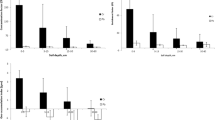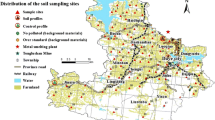Abstract
Tannery-affected surface soils from 72 sampling sites from industrial area of Sialkot district, Pakistan, were collected and analyzed for nine physicochemical parameters, nine heavy metals, and four macro-nutrients. Most of the soils were poor in organic matter (0.11–2.98 %), basic in nature with pH (7.1–10.6) and electrical conductivity (1.2–17.9 mS/cm). Mean concentration of total dissolved solids, Cl1−, alkalinity, NO 13 -N, salinity, and PO4 3− was 3,093 mg/L, 6,587, 3,929, 301.3, 10.3, and 1.7 mg/kg. The results showed that concentration of macro-nutrients was in the order: Na>Mg>K>Ca whereas heavy metals followed the order: Cr>Fe>Ni>Mn>Cu>Zn>Co>Pb>Cd. Factor analysis based on principal component analysis, cluster analysis, and correlation analysis identified contribution of metals from tannery effluents, agrochemicals, automobiles exhaust, and natural weathering processes. Tannery-affected soils were enriched with Cd followed by Cr, Pb, Ni, Cu, Co, Zn, and Mn. Geo-accumulation index (I geo) classified the soil samples in unpolluted to moderately polluted categories. Metal pollution index provided better estimation of heavy metal pollution as compared to pollution load index. Ecological risk index showed high potential ecological risk associated with Cd and Cr with mean concentrations above respective average shale/background values. The results are useful for heavy metals source identification, enrichment, risk assessment, and management of tannery-affected soils and can contribute to monitoring programs at regional levels.




Similar content being viewed by others
References
Abrahim GMS, Parker RJ (2008) Assessment of heavy metal enrichment factors and the degree of contamination in marine sediments from Tamaki Estuary Auckland New Zealand. Environ Monit Assess 136:227–238
Alloway BJ (1990) Heavy metals in soils. Wiley, New York
APHA (1998) Standard methods for water and wastewater examination, 20th edn. American Public Health Association, Washington
Bermudez GMA, Moreno M, Invernizzi R, Plá R, Pignata ML (2010) Heavy metal pollution in topsoils near a cement plant: the role of organic matter and distance to the source to predict total and HCl-extracted heavy metal concentrations. Chemosphere 78:375–381
Beyer WN (2001) Estimating toxic damage to soil ecosystems from soil organic matter profiles. Ecotoxicology 10:273–283
Braungardt CB, Achterberg EP, Elbaz-Poulichet F, Morley NH (2003) Metal geochemistry in a mine-polluted estuarine system in Spain. Appl Geochem 18:1757–1771
Cao HC, Luan ZQ, Wang JD, Zhang XL (2007) Potential ecological risk of cadmium lead and arsenic in agricultural black soil in Jilin province China. Stoch Environ Res Risk Assess 23:57–64
Chandra R, Bharagavaa RN, Yadava S, Mohan D (2009) Accumulation and distribution of toxic metals in wheat (Triticum aestivum L) and Indian mustard (Brassica campestris L.) irrigated with distillery and tannery effluents. J Hazard Mater 162:1514–1521
Chaney RL, Ryan JA (1993) Heavy metal and toxic organic pollutants in MSW composts: research results on phytoavailabilty bioavailability etc. In: Hoitink HAJ, Keener HM (eds) Science and engineering of composting: design environmental. Microbiological and Utilization Aspects Renaissance Publications, Washington, pp 451–506
Chinese Environmental Protection Agency and Chinese General Station of Environmental Monitoring (CEPA and CGSEM) (1990) Soil chemical element background values of China. Chinese Environmental Science Press, Beijing (in Chinese)
Dantu S (2009) Heavy metals concentration in soils of southeastern part of Ranga Reddy district Andhra Pradesh India. Environ Monit Assess 149:213–222
Equeenuddin SKMD, Tripathy S, Sahoo PK, Panigrahi MK (2013) Metal behavior in sediment associated with acid mine drainage stream: role of pH. J Geochem Explor 124:230–237
Forstner U, Ahlf W, Calmano W, Kersten M (1990) Sediments criteria development-contributions from environmental geochemistry to water quality management sediments and environmental geochemistry: selected aspects and case histories. Springer, Berlin, pp 311–338
Gowd SS, Reddy MR, Govil PK (2010) Assessment of heavy metal contamination in soils at Jajmau (Kanpur) and Unnao industrial areas of the Ganga Plain Uttar Pradesh India. J Hazard Mater 174:113–121
Hakanson L (1980) An ecological risk index for aquatic pollution control; a sedimentological approach. Water Res 14:975–1001
Hooda PS, Mcnulty D, Alloway BJ, Aitken MN (1997) Plant availability of heavy metals in soils previously amended with heavy applications of sewage sludge. J Food Agric 73:446–454
Kabata-Pendias A (2004) Soil-plant transfer of heavy metals-an environmental issue. Geoderma 122:143–149
Long ER, Morgan LG (1991) The potential for biological effects of sediment-sorbed contaminants tested in the national status and trends program NOAA technical memorandum NOS OMA 52. National Oceanic and Atmospheric Administration, Seattle, p 175
Malik RN, Jadoon WA, Hussain SZ (2010) Metal contamination of surface soils of industrial city Sialkot Pakistan: a multivariate and GIS Approach. Environ Geochem Health 32:179–191
McLaughlin MJ, Whatmuff M, Warne M, Heemsbergen D, Barry G, Bell M, Nash D, Pritchard D (2006) A field investigation of solubility and food chain accumulation of biosolid-cadmium across diverse soil types. Environ Chem 3:428–432
Muller G (1979) Schwermetalle in den sedimenten des Rheins-Veränderungen seitt 1971. Umschan 79:778–783 (in German with English abstract)
Nikolskii NN (1963) Practical soil science. Technical Services US Department Commerce, Washington DC, p 240
Qadir A, Malik RN (2011) Heavy metals in eight edible fish species from two polluted tributaries (Aik and Palkhu) of the River Chenab, Pakistan. Biol Trace Elem Res 143:1524–1540
Qadir A, Malik RN, Husain SZ (2008) Spatio-temporal variations in water quality of Nullah Aik-tributary of the River Chenab Pakistan. Environ Monit Assess 140:43–59
Smith SL, MacDonald DD, Keenleyside KA, Ingersoll CG, Field J (1996) A preliminary evaluation of sediment quality assessment values for freshwater ecosystems. J Great Lakes Res 22:624–638
Tariq SR, Shah MH, Shaheen N, Khalique A, Manzoor S, Jaffar M (2005) Multivariate analysis of selected metals in tannery effluents and related soil. J Hazard Mater 122:17–22
Tariq SR, Shah MH, Shaheen N, Khalique A, Manzoor S, Jaffar M (2006) Multivariate analysis of trace metal level in tannery effluents in relation to soil and water: a case study from Peshawar Pakistan. J Environ Manag 79:20–29
Tariq SR, Shah MH, Shaheen N (2009) Comparative statistical analysis of chrome and vegetable tanning effluents and their effects on related soil. J Hazard Mater 169:285–290
Tomlinson DL, Wilson JG, Harris CR, Jeffrey DW (1980) Problems in the assessment of heavy metal levels in estuaries and the formation of a pollution index. Helgolaender Meeresuntersuchungen 33:566–575
Turekian KK, Wedepohl KH (1961) Distribution of the elements in some major units of the earth’s crust. Bull Geol Soc Am 72:175–192
Usero J, Garcia A, Fraidias J (2000) Calidad de las aguas y sedimentos del Litoral Andaluz in: Junta de Andalicia Consejeria del Medio Ambiente Sevilla (Editorial): 164
Wei B, Jiang F, Li X, Mu S (2010) Heavy metal induced ecological risk in the city of Urumqi NW China. Environ Monit Assess 160:33–45
Zonta R, Zaggia L, Argrse E (1994) Heavy metal and grain size distributions in estuarine shallow water sediments of the Cona Marsh (Venice Lagoon Italy). Sci Total Environ 151:19–28
Acknowledgments
We are thankful to the reviewers for their constructive comments and valuable suggestions, which greatly improved the manuscript’s quality. We also gratefully acknowledge the Faculty of Biological Sciences for provision of metal analysis facilities and Pakistan Wetlands Programme for transport facility.
Author information
Authors and Affiliations
Corresponding author
Rights and permissions
About this article
Cite this article
Ali, Z., Malik, R.N., Shinwari, Z.K. et al. Enrichment, risk assessment, and statistical apportionment of heavy metals in tannery-affected areas. Int. J. Environ. Sci. Technol. 12, 537–550 (2015). https://doi.org/10.1007/s13762-013-0428-4
Received:
Revised:
Accepted:
Published:
Issue Date:
DOI: https://doi.org/10.1007/s13762-013-0428-4




